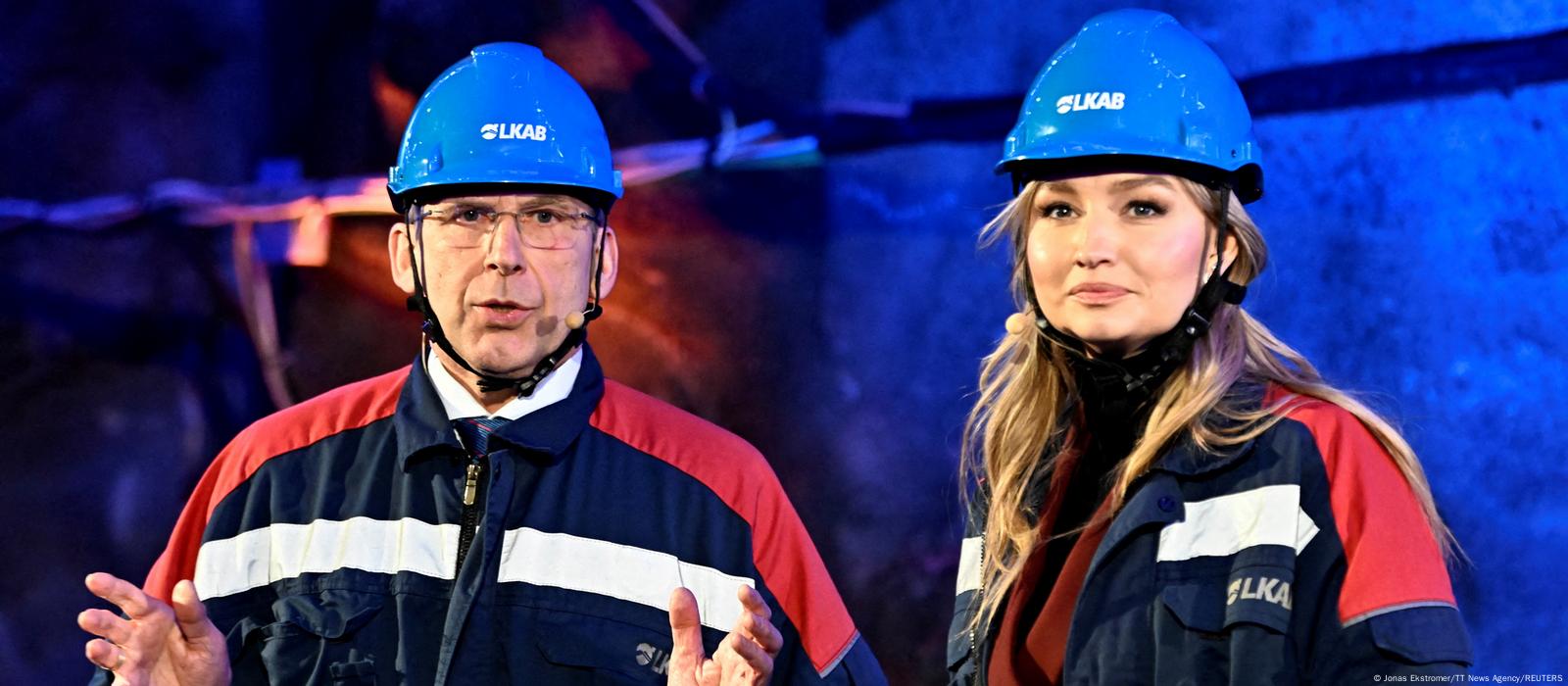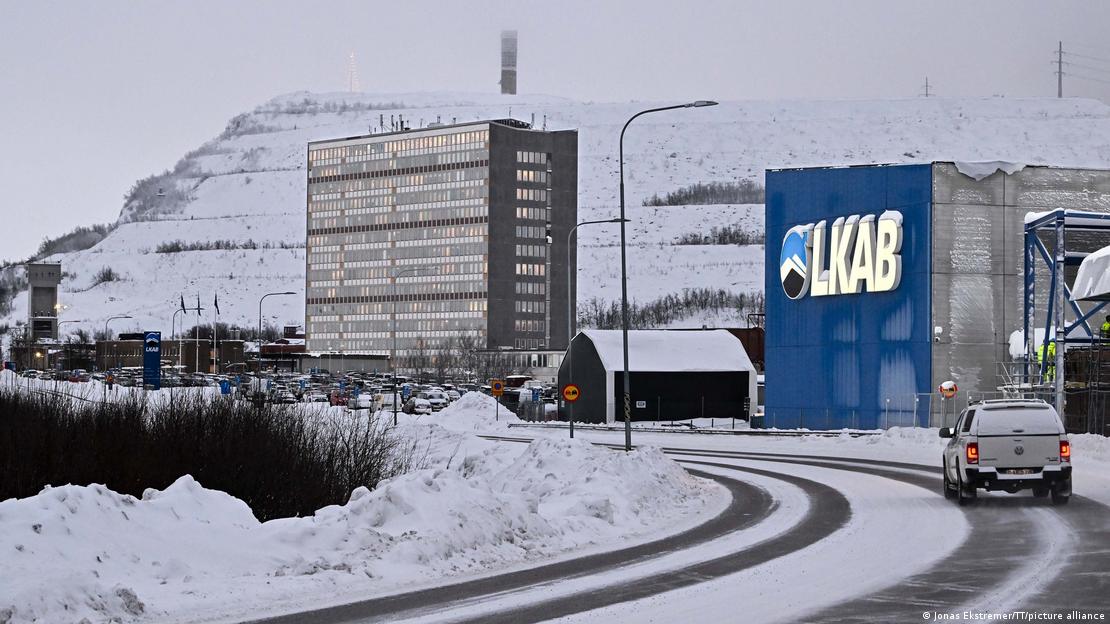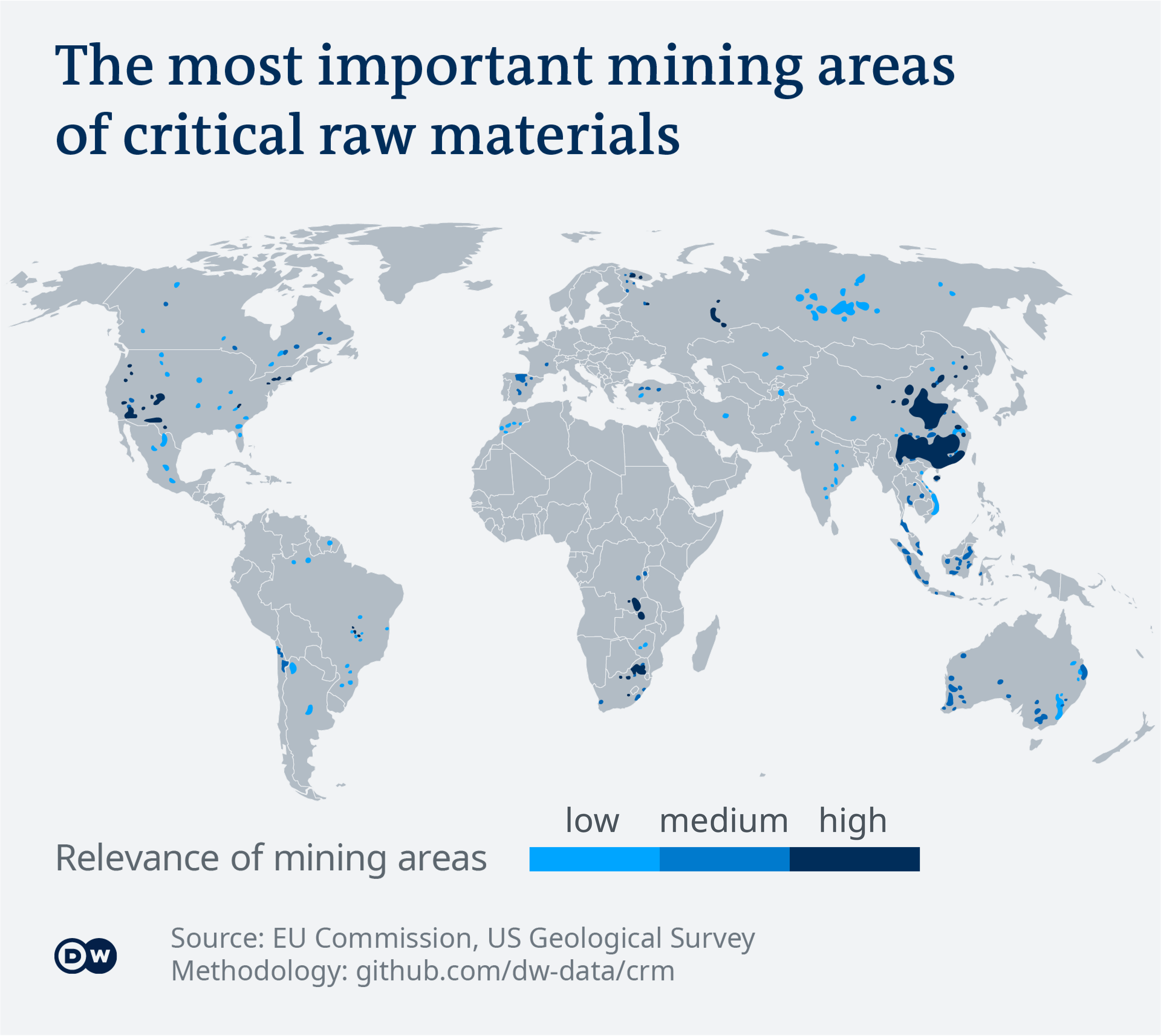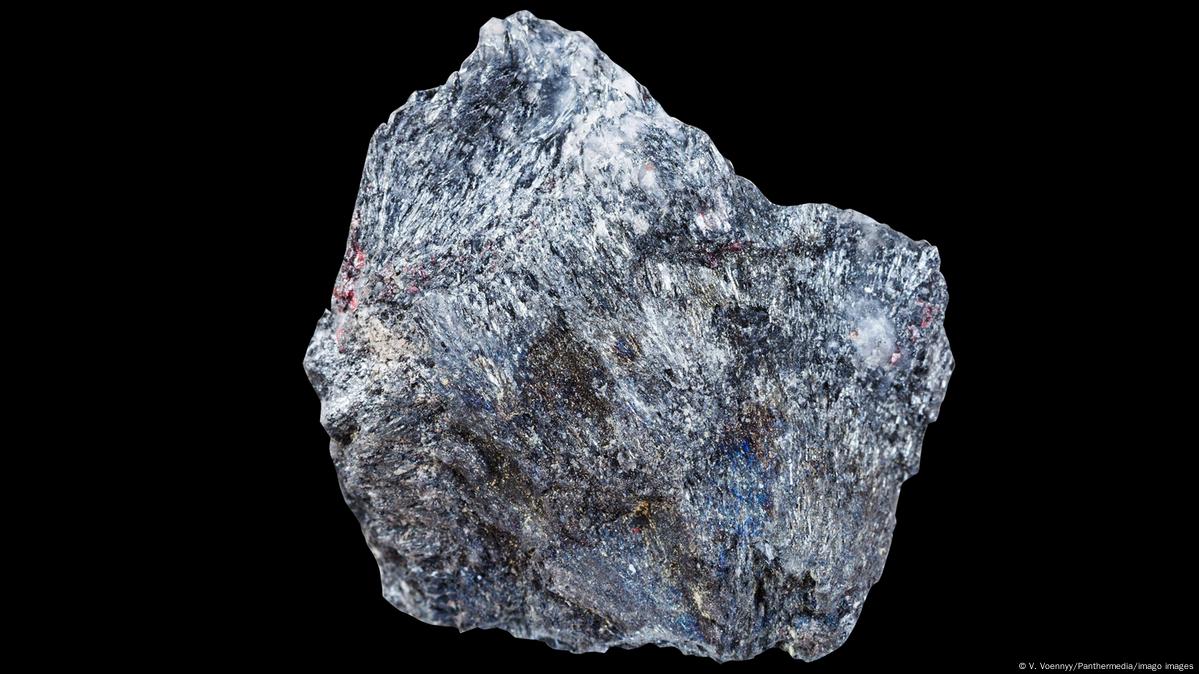MINING IS NOT GREEN

Rare earths find in Sweden: A gamechanger?
Arthur Sullivan
DW
January 13, 2023
A big find of raw materials critical for green technology has been announced in Sweden. Since Europe does not produce its own so-called 'rare earths' so far could this news be a gamechanger?
The Swedish state-owned mining company LKAB announced on Thursday that it had found more than a million tons of rare earth oxides in Kiruna, northern Sweden.
Rare earth elements, also known as rare earth metals or rare earth oxides, are a set of 17 heavy metals which have a wide range of commercial and industrial uses. They are of particular importance for the green transition, as they are needed for the production of wind turbines and electric vehicles.
However, the EU is heavily dependent on importing them or the compounds they are needed for.
Jan Moström, CEO of LKAB, said in a statement that the find was good news for "Europe and the climate", adding "it could become a significant building block for producing the critical raw materials that are absolutely crucial to enable the green transition."
Experts say the size of the find still needs to be verified but the estimate from the company of 1 million tons would make it the largest of its kind in Europe.
Is this a big surprise?
Not really. The deposit, dubbed Per Geijer, is located in the Swedish portion of the Arctic Circle, which has been known to be rich in rare earth minerals for several decades. LKAB already runs the largest iron ore mine in Europe and their exploration for rare earths in Kiruna has been widely publicized.

In Europe, there are heavy regulatory barriers to the mining and production of critical raw materials and it does not currently mine raw earths. As a result, the EU is heavily dependent on China and other countries for them.
That has become a major political issue given how the EU wants to both end trade dependencies on China and Russia and boost its own green technologies to achieve its climate goals. The $369-billion (€340-billion) Inflation Reduction Act in the US, which gives massive subsidies to green technologies, has also ramped up the pressure on the EU.
So how significant could this find be for Europe?
"Superlative claims abound whenever a new rare earth deposit is announced, so it is important to look at the data," Julie Klinger, a professor of geography at the University of Delaware, told DW.
"If you take a look back at the headlines concerning rare earth deposits in Greenland, North Korea, Afghanistan, Turkey, the ocean floor, the Moon: all are claimed to be the largest or one of the largest," she added, stressing the need for the find to be verified.
Nabeel Mancheri, secretary-general of the Global Rare Earth Industry Association, says a lot more work is needed to determine the quality of the deposit.
"Economically speaking, these are not 'reserves' yet. You still need a lot of drilling, a lot of testing, and you don't have the full information about what quality the ore grade is yet," he told DW.
Klinger says the find could potentially end up being an alternative source for Europe's rare earth needs, but said it would take between 10 and 15 years to develop a mine, which is in line with the company's own estimates.
"This is not just because of the permitting, although that is often blamed. It is a monumental construction and engineering feat to open a new mine," she said.
What needs to happen now?
In order for LKAB to exploit the discovery, they would need to drive a change in how the EU approaches the issue of mining for such raw materials.
"The EU has long since discarded mining as something that 'we don't want to be in our backyard,'" said Mancheri.
LKAB CEO Moström says he hopes the stringent permitting processes for mining within the EU can be sped up in order for the company to bring finished materials more quickly to market. "If we really want to pursue the green transition we must find ways to speed up this process quite substantially," he said at a press conference.
The European Commission is currently working on lowering the barriers to the mining and production of critical raw materials for the green transition.

However, Mancheri says establishing a mining industry is still only half the job. "Once you have the mining, you also need to establish the processing industry," he said, referring to the complex and hugely energy intensive processes of isolating and refining rare earths.
Will the rare earths only be used for the green transition?
Experts say this is a critical question, as rare earths are also used in many polluting industries.
"Although most of the press releases emphasize the importance of rare earth elements for renewable energy technologies, rare earth elements are also important for petroleum refining and are important for military-industrial applications," said Klinger.
"There is currently no policy in place, in the EU or elsewhere, that protects materials mined in the name of climate change from capture by other, less climate-friendly sectors. Even the Swedish state-owned LKAB, or any other mining company for that matter, is not required to sell its output to firms in the renewable energy technologies sector."
She says that if mining firms such as LKAB are to demand that the permit process is sped up for them in the name of fighting climate change, there must be EU rules which prevent the output going to non-green sectors.
Edited by: Uwe Hessler
Critical raw materials: Toxic, rare and irreplaceable
Thirty rare elements have been identified as critical for the future of industry. Some of them have a colorful history.

Baryte: The 'heavy' crystal
Baryte, which means "heavy" in Greek, is a barium sulfate, commonly found in lead-zinc veins in limestone. Its crystals, which often grow in sand and contain grains of sand within their structure, form into clusters known as baryte roses. Baryte can be clear, or can shimmer in hues of yellow, red, green or pale blue.
January 13, 2023
A big find of raw materials critical for green technology has been announced in Sweden. Since Europe does not produce its own so-called 'rare earths' so far could this news be a gamechanger?
The Swedish state-owned mining company LKAB announced on Thursday that it had found more than a million tons of rare earth oxides in Kiruna, northern Sweden.
Rare earth elements, also known as rare earth metals or rare earth oxides, are a set of 17 heavy metals which have a wide range of commercial and industrial uses. They are of particular importance for the green transition, as they are needed for the production of wind turbines and electric vehicles.
However, the EU is heavily dependent on importing them or the compounds they are needed for.
Jan Moström, CEO of LKAB, said in a statement that the find was good news for "Europe and the climate", adding "it could become a significant building block for producing the critical raw materials that are absolutely crucial to enable the green transition."
Experts say the size of the find still needs to be verified but the estimate from the company of 1 million tons would make it the largest of its kind in Europe.
Is this a big surprise?
Not really. The deposit, dubbed Per Geijer, is located in the Swedish portion of the Arctic Circle, which has been known to be rich in rare earth minerals for several decades. LKAB already runs the largest iron ore mine in Europe and their exploration for rare earths in Kiruna has been widely publicized.

LKAB already controls Europe's largest iron ore mine
Image: Jonas Ekstremer/TT/picture alliance
How rare are rare earths and who has them all?
Despite the name, rare earths are plentiful in many parts of the world but mining and extracting them is extremely complex and costly. It can also be very damaging to the environment.
China has by far the largest amount of rare earth reserves of any country in the world, followed by Vietnam, Brazil and Russia. However, in terms of refining and processing rare earths, China is further ahead: according to data from the US Geological Survey, it accounted for more than 60% of all rare earths production as of January 2022, followed by the US (16%), Myanmar (9%) and Australia (8%).
Despite the name, rare earths are plentiful in many parts of the world but mining and extracting them is extremely complex and costly. It can also be very damaging to the environment.
China has by far the largest amount of rare earth reserves of any country in the world, followed by Vietnam, Brazil and Russia. However, in terms of refining and processing rare earths, China is further ahead: according to data from the US Geological Survey, it accounted for more than 60% of all rare earths production as of January 2022, followed by the US (16%), Myanmar (9%) and Australia (8%).
In Europe, there are heavy regulatory barriers to the mining and production of critical raw materials and it does not currently mine raw earths. As a result, the EU is heavily dependent on China and other countries for them.
That has become a major political issue given how the EU wants to both end trade dependencies on China and Russia and boost its own green technologies to achieve its climate goals. The $369-billion (€340-billion) Inflation Reduction Act in the US, which gives massive subsidies to green technologies, has also ramped up the pressure on the EU.
So how significant could this find be for Europe?
"Superlative claims abound whenever a new rare earth deposit is announced, so it is important to look at the data," Julie Klinger, a professor of geography at the University of Delaware, told DW.
"If you take a look back at the headlines concerning rare earth deposits in Greenland, North Korea, Afghanistan, Turkey, the ocean floor, the Moon: all are claimed to be the largest or one of the largest," she added, stressing the need for the find to be verified.
Nabeel Mancheri, secretary-general of the Global Rare Earth Industry Association, says a lot more work is needed to determine the quality of the deposit.
"Economically speaking, these are not 'reserves' yet. You still need a lot of drilling, a lot of testing, and you don't have the full information about what quality the ore grade is yet," he told DW.
Klinger says the find could potentially end up being an alternative source for Europe's rare earth needs, but said it would take between 10 and 15 years to develop a mine, which is in line with the company's own estimates.
"This is not just because of the permitting, although that is often blamed. It is a monumental construction and engineering feat to open a new mine," she said.
What needs to happen now?
In order for LKAB to exploit the discovery, they would need to drive a change in how the EU approaches the issue of mining for such raw materials.
"The EU has long since discarded mining as something that 'we don't want to be in our backyard,'" said Mancheri.
LKAB CEO Moström says he hopes the stringent permitting processes for mining within the EU can be sped up in order for the company to bring finished materials more quickly to market. "If we really want to pursue the green transition we must find ways to speed up this process quite substantially," he said at a press conference.
The European Commission is currently working on lowering the barriers to the mining and production of critical raw materials for the green transition.

However, Mancheri says establishing a mining industry is still only half the job. "Once you have the mining, you also need to establish the processing industry," he said, referring to the complex and hugely energy intensive processes of isolating and refining rare earths.
Will the rare earths only be used for the green transition?
Experts say this is a critical question, as rare earths are also used in many polluting industries.
"Although most of the press releases emphasize the importance of rare earth elements for renewable energy technologies, rare earth elements are also important for petroleum refining and are important for military-industrial applications," said Klinger.
"There is currently no policy in place, in the EU or elsewhere, that protects materials mined in the name of climate change from capture by other, less climate-friendly sectors. Even the Swedish state-owned LKAB, or any other mining company for that matter, is not required to sell its output to firms in the renewable energy technologies sector."
She says that if mining firms such as LKAB are to demand that the permit process is sped up for them in the name of fighting climate change, there must be EU rules which prevent the output going to non-green sectors.
Edited by: Uwe Hessler
Critical raw materials: Toxic, rare and irreplaceable
Thirty rare elements have been identified as critical for the future of industry. Some of them have a colorful history.
2/9
Image: John Cancalosi/Nature Picture Library/imago images
Antimony: The pharaoh's eyeliner
Antimony is a gray metalloid, which is often used to harden other metals. The origin of its name is disputed. One speculation claims it derives from "anti" and "monos," which collectively mean "a metal not found alone". Antimony often occurs as a compound. In ancient Egypt and ancient India, it was powdered and used as medicine or compressed into sticks for use as cosmetics — especially eyeliner.

Antimony: The pharaoh's eyeliner
Antimony is a gray metalloid, which is often used to harden other metals. The origin of its name is disputed. One speculation claims it derives from "anti" and "monos," which collectively mean "a metal not found alone". Antimony often occurs as a compound. In ancient Egypt and ancient India, it was powdered and used as medicine or compressed into sticks for use as cosmetics — especially eyeliner.
Image: V. Voennyy/Panthermedia/imago images

Baryte: The 'heavy' crystal
Baryte, which means "heavy" in Greek, is a barium sulfate, commonly found in lead-zinc veins in limestone. Its crystals, which often grow in sand and contain grains of sand within their structure, form into clusters known as baryte roses. Baryte can be clear, or can shimmer in hues of yellow, red, green or pale blue.
No comments:
Post a Comment